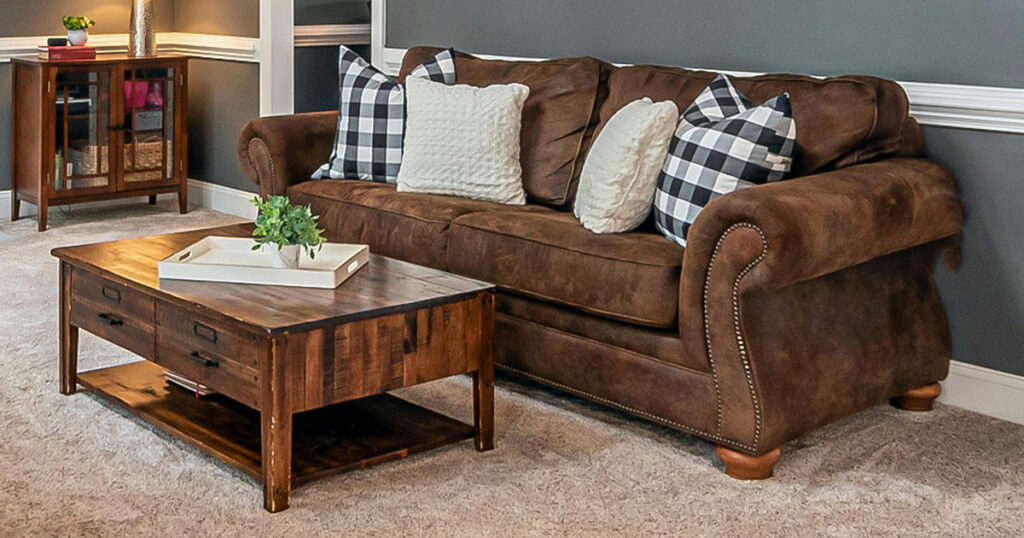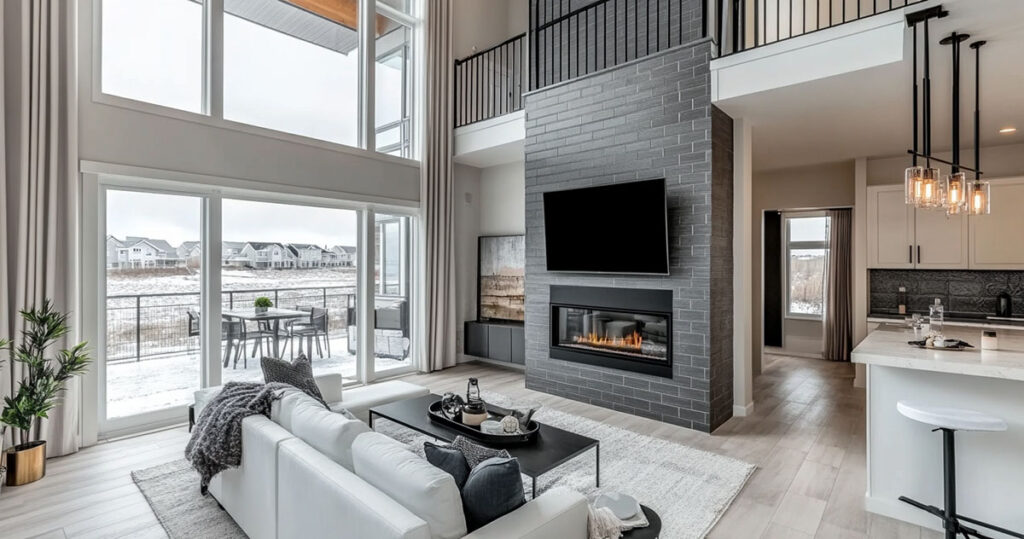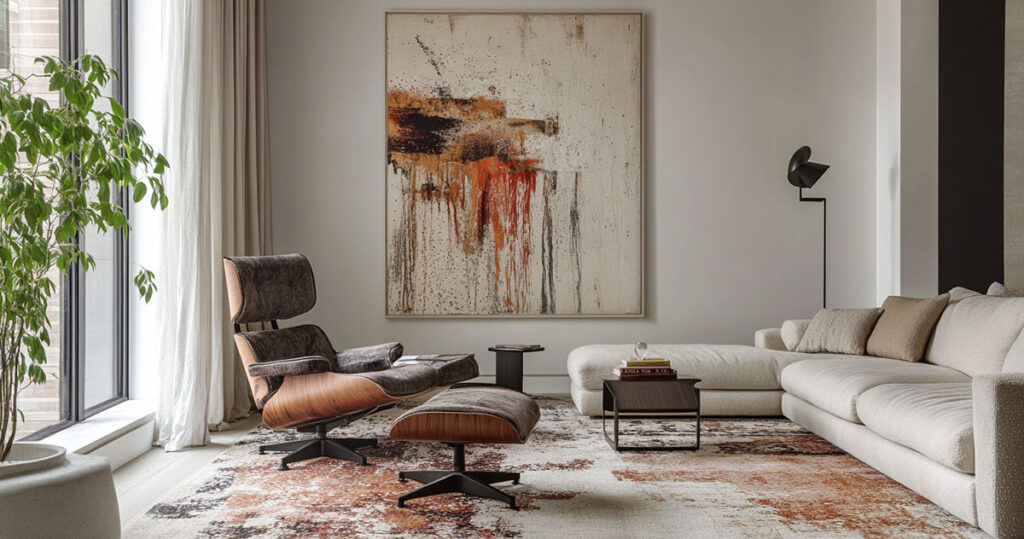Have you ever walked into a beautiful room and wondered why it feels so complete and harmonious? Often, the secret lies right beneath your feet. The right rug doesn’t just protect your floors—it ties your entire design together, adding warmth, texture, and personality to your space.
But with so many interior styles and countless rug options, how do you choose the perfect match? Let’s explore the most popular North American interior styles and discover how to select rugs that will enhance your home’s unique character.
Traditional American Style
Traditional American interiors draw inspiration from 18th and 19th-century European designs, creating spaces that feel elegant, timeless, and comfortable. These rooms typically feature ornate dark wood furniture, rich upholstery fabrics, and classic patterns.
Rug Recommendations:
For traditional living rooms, Persian or Oriental rugs with rich reds, blues, or navy tones work beautifully. These rugs complement dark wood furniture and add warmth to the space. In bedrooms, lighter rugs in soft neutrals like cream or light gold create a calming atmosphere. For home offices, deep-toned rugs with burgundy and navy details lend a scholarly, professional air.
When selecting a rug for a traditional space, look for high-quality Oriental rugs that tie together your room’s color scheme. Choose a rug with accent colors that appear in your upholstery or curtains for a harmonious look. Traditional patterns like medallions, Kashan, or Heriz designs enhance the timeless atmosphere.
Transitional Style (Traditional Meets Contemporary)
Transitional design blends classic sophistication with modern simplicity—perfect for those who find traditional style too formal or modern design too sleek. This style features clean furniture lines, a mix of materials (wood, rattan, steel), and a neutral color palette with occasional pops of color.
Rug Recommendations:
In transitional living rooms, opt for neutral or muted tones that complement your furniture. A light gray, cream, or sand rug with a subtle pattern or two-tone design grounds the seating area without dominating it. For bedrooms, plush rugs in beige, ivory, or pale grey-blue add warmth and comfort. In offices, low-pile rugs in neutral hues like taupe or slate gray maintain professionalism while adding interest.
Keep your rug design relatively simple to maintain the balance of transitional spaces. Look for rugs with textural interest, such as carved patterns or a mix of loop and cut pile, in a single color. This adds depth while staying within a muted palette. Subtle echo of traditional patterns in a modern, monochromatic form (like a tone-on-tone damask) works well for this style.
Mid-Century Modern
Mid-century modern design emerged in the 1950s-1960s and remains extremely popular today. It features clean lines, organic curves, and a functional approach that still feels warm and inviting. Iconic furniture pieces, tapered legs, and natural materials like wood, leather, and chrome are hallmarks of this style.
Rug Recommendations:
For a true mid-century vibe in living rooms, consider geometric patterned rugs with retro colors—think atomic-era shapes in orange, brown, and cream. Alternatively, a solid shag rug in avocado green or off-white adds texture and fun. In bedrooms, a low-pile rug in a calming solid tone from the era’s palette (muted teal or mustard) complements wood furniture beautifully. For offices, simple flatweave rugs in neutral tones work well, possibly with a slight nubby texture for interest.
Mid-century modern style allows versatility with rugs—you can either use the rug to highlight the era’s boldness or its simplicity. If your furniture and art are understated, an eye-catching rug pattern can serve as a focal point. Conversely, if you have iconic patterned wallpaper or a bright sofa, a neutral rug will ground the space perfectly.
Contemporary Minimalist Style
Contemporary minimalist design emphasizes clean lines, open spaces, and a “less is more” philosophy. This style creates interiors that feel airy, uncluttered, and sleek, yet can be made warm with the right materials. Furniture tends to have simple geometric forms, and surfaces are often plain and smooth.
Rug Recommendations:
In minimalist living rooms, solid or subtly patterned rugs in neutral tones are preferred. An off-white rug can unify a seating area with a white sofa, making the space feel continuous. For contrast in bright rooms, a charcoal gray or black rug with a low-key pattern can anchor the space. In bedrooms, soft, muted colors like pale taupe, silver-gray, or dusty beige contribute to a tranquil atmosphere. For offices, low-pile commercial-style rugs in medium gray or slate blue provide a professional, clean look.
Simplicity is key for minimalist rugs—they should have a simple design that almost blends into the environment. Monochrome rugs (one color throughout, possibly with slight variations in weave or pile) are very popular. Texture can add interest without disrupting the minimalist vibe, so consider nubby wool rugs or flatweave kilims.
Industrial Loft Style
Industrial style draws inspiration from converted warehouses and urban lofts, showcasing structural elements and finding beauty in utilitarian materials. This edgy, raw style features exposed architecture (pipes, ducts, beams), brick walls, concrete or weathered wood floors, and metal-legged furniture.
Rug Recommendations:
For industrial loft living areas, vintage or worn-look rugs work perfectly. A Persian-style rug with faded reds and blues introduces color and a sense of history. Alternatively, a flatweave kilim in earthy tones (rust, navy, beige) can echo the brick and steel surroundings. In bedrooms, a cowhide rug or sheepskin thrown on the floor adds softness against rough floors. For offices, durability and simplicity are key—consider a low-pile rug in charcoal gray or steel blue, or commercial carpet tiles in alternating shades of gray.
Embrace patina and character in rugs for industrial spaces. Oriental or Persian rugs add a bohemian counterpoint to all the metal and brick, making a loft feel more like a home. Natural fiber rugs (jute, sisal, seagrass) in a coarse weave also complement the rawness of concrete or wood floors with their rough texture.
Farmhouse & Rustic Style
Farmhouse style celebrates comfort, warmth, and nostalgia, inspired by rural farm homes but evolved into a modern, upscale “modern farmhouse” version in recent years. This style features natural materials, handcrafted items, and a lived-in charm—think exposed wood beams, shiplap walls, and hearty wooden furniture.
Rug Recommendations
In farmhouse living rooms, natural fiber rugs or earthy-colored rugs work well. A large jute or sisal rug in a golden tan adds texture and echoes the natural theme. For bedrooms, a warm ivory or light beige shag rug makes the space feel like a retreat. Alternatively, use a flat-weave cotton rug with classic country patterns (subtle stripes or florals in soft sage or sky-blue). In home offices with rustic flair, a kilim or tribal rug in earthy reds, browns, and creams brings warmth.
Farmhouse style allows for creative rug choices because both homemade-looking textiles and vintage pieces fit right in. Braided rugs, natural fiber rugs, and faded or tribal-pattern oriental rugs complement the no-frills aesthetic. When selecting colors, draw from your existing décor—if you have a lot of white and black contrast (common in modern farmhouse), a jute rug ties in nicely with that neutral backdrop.
Coastal / Nautical Style
Coastal style is inspired by beach houses and ocean vistas, aiming to bring seaside charm indoors. Popular in coastal regions like New England and California, it features bright, airy spaces with light colors, natural textures, and subtle maritime elements.
Rug Recommendations:
For coastal living rooms, light-colored rugs dominate. A classic choice is a rug with nautical stripes—a flatweave cotton rug in white and navy immediately signals a nautical theme. Another option is a solid jute or sisal rug in sandy beige, which literally brings the texture of sand into the room. In bedrooms, a soft blue or teal rug creates a tranquil atmosphere, echoing the ocean. For offices with a coastal vibe, neutral or cool tones ground the space—a navy blue rug with a white trellis pattern introduces a refined nautical touch.
The rugs in coastal design often emphasize texture and natural materials. Sisal or seagrass rugs are very popular—their rough texture and sandy color mimic the feeling of walking on a beach. Consider a rug that incorporates a pop of ocean blue or soft green to tie in with accent pillows or art. Coastal-themed rugs can also be subtly patterned with wave-like designs, coral silhouettes, or lattices resembling fishnet.
Bohemian & Eclectic Style
Bohemian style is a free-spirited, eclectic approach that embraces a mix of colors, patterns, and cultures. It features textiles (throws, tapestries, floor cushions), natural materials (rattan, jute, carved wood), and collected decor from different places and eras. The overall impression is personal and story-rich rather than following a formula.
Rug Recommendations:
Boho living rooms love layered rugs and bold patterns. A classic foundation is a Persian or Moroccan rug with rich colors—a red and navy Persian carpet or a multicolored Moroccan Boujad rug. In bohemian bedrooms, comfort is key. A shaggy Moroccan Beni Ourain rug (cream with black diamond pattern) provides a soft landing and a trendy boho look. For home offices with bohemian style, a flatweave kilim rug under the desk with geometric designs and bright colors can spark creativity.
Bohemian style is extremely rug-friendly—the more the merrier. You can mix and match rug styles: Persian, Turkish, Moroccan, Navajo, Indian can all coexist if the color palettes connect somehow. For instance, you might have a large jute rug layered with a smaller colorful kilim at an angle in one corner. When selecting colors, pick out 2-3 colors from that rug and repeat them in the room to create cohesion amid the variety.
Southwestern Style
Southwestern style reflects the heritage of the Southwestern United States, blending Native American and Spanish Colonial influences through a desert-inspired lens. Known for its warm, earthy atmosphere and handcrafted look, this style features adobe architecture, handcrafted elements, and nature-inspired colors.
Rug Recommendations:
Flat-woven tribal rugs are a staple in Southwestern living rooms. A classic choice is a Zapotec or Navajo rug with patterns in rust, black, ivory, and turquoise. For Southwestern bedrooms, you could use a soft kilim rug in lighter desert tones or a cowhide rug for rustic Western flair. In home offices, a subtle approach might be best—consider a rug with Southwestern-inspired pattern in neutral colors or a medium-toned rug in a single color drawn from the palette.
Authenticity adds value in Southwestern interiors. Consider using authentic Native American rugs or Mexican textiles if possible—their hand-dyed colors and symbolic patterns carry cultural significance. When coordinating, note that many Southwestern rugs are statement pieces with vibrant colors and bold patterns, so let the rug dictate the room’s accent colors.
Hollywood Glam (Art Deco Revival)
Hollywood Glam, also known as Hollywood Regency, is a dramatic and luxurious style that originated in the homes of Hollywood’s Golden Age stars. It blends Art Deco opulence with Mid-Century Modern influences, creating interiors that are chic, elegant, and a bit indulgent. Hallmarks include high-contrast color schemes, glossy finishes, and statement pieces.
Rug Recommendations:
In Hollywood glam living rooms, high-contrast rugs like a black and white Greek key pattern or bold stripe reinforce Art Deco geometric motifs. Alternatively, a solid plush rug in a rich color (deep emerald green or royal purple) feels sumptuous, especially if the furniture is mostly neutral. In glam bedrooms, a faux fur white rug draped beside the bed adds Hollywood decadence.
For stylish offices, a sleek cowhide rug (either natural or dyed metallic silver/gold) under a shiny desk adds unexpected sophistication.
In Hollywood Glam, a rug is another opportunity to make a glamorous statement. Consider rugs with silk or viscose content that have a bit of shine, as these catch the light and signal luxury. Animal hides (zebra, cowhide, leopard) in rug form are classic elements of Hollywood Regency. If customizing a rug, you could incorporate a personal monogram or a custom Art Deco pattern to amp up the exclusivity factor.
Ready to Find Your Perfect Rug?
Now that you understand how different rug styles complement various interior designs, you’re ready to make an informed choice for your home. Browse our collection of custom tufted rugs designed to enhance any North American interior style.
Our team of experts is available to help you select the perfect materials, colors, and patterns to bring your vision to life.
Contact us today for a free consultation or to request samples of our premium materials. Your dream rug—and the perfect finishing touch for your space—is just a conversation away!




